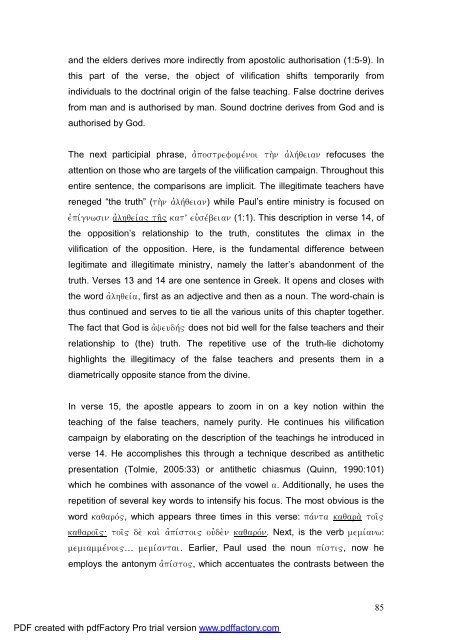A Text centred rhetorical analysis of Paul's Letter to Titus
A Text centred rhetorical analysis of Paul's Letter to Titus
A Text centred rhetorical analysis of Paul's Letter to Titus
You also want an ePaper? Increase the reach of your titles
YUMPU automatically turns print PDFs into web optimized ePapers that Google loves.
and the elders derives more indirectly from apos<strong>to</strong>lic authorisation (1:5-9). In<br />
this part <strong>of</strong> the verse, the object <strong>of</strong> vilification shifts temporarily from<br />
individuals <strong>to</strong> the doctrinal origin <strong>of</strong> the false teaching. False doctrine derives<br />
from man and is authorised by man. Sound doctrine derives from God and is<br />
authorised by God.<br />
The next participial phrase, ajpostrefomevnoi th;n ajlhvqeian refocuses the<br />
attention on those who are targets <strong>of</strong> the vilification campaign. Throughout this<br />
entire sentence, the comparisons are implicit. The illegitimate teachers have<br />
reneged “the truth” (th;n ajlhvqeian) while Paul’s entire ministry is focused on<br />
ejpivgnwsin ajlhqeiva" th`" katÆ eujsevbeian (1:1). This description in verse 14, <strong>of</strong><br />
the opposition’s relationship <strong>to</strong> the truth, constitutes the climax in the<br />
vilification <strong>of</strong> the opposition. Here, is the fundamental difference between<br />
legitimate and illegitimate ministry, namely the latter’s abandonment <strong>of</strong> the<br />
truth. Verses 13 and 14 are one sentence in Greek. It opens and closes with<br />
the word ajlhqeiva, first as an adjective and then as a noun. The word-chain is<br />
thus continued and serves <strong>to</strong> tie all the various units <strong>of</strong> this chapter <strong>to</strong>gether.<br />
The fact that God is ajyeudhv" does not bid well for the false teachers and their<br />
relationship <strong>to</strong> (the) truth. The repetitive use <strong>of</strong> the truth-lie dicho<strong>to</strong>my<br />
highlights the illegitimacy <strong>of</strong> the false teachers and presents them in a<br />
diametrically opposite stance from the divine.<br />
In verse 15, the apostle appears <strong>to</strong> zoom in on a key notion within the<br />
teaching <strong>of</strong> the false teachers, namely purity. He continues his vilification<br />
campaign by elaborating on the description <strong>of</strong> the teachings he introduced in<br />
verse 14. He accomplishes this through a technique described as antithetic<br />
presentation (Tolmie, 2005:33) or antithetic chiasmus (Quinn, 1990:101)<br />
which he combines with assonance <strong>of</strong> the vowel a. Additionally, he uses the<br />
repetition <strong>of</strong> several key words <strong>to</strong> intensify his focus. The most obvious is the<br />
word kaqarov~, which appears three times in this verse: pavnta kaqara; <strong>to</strong>i`"<br />
kaqaroi`": <strong>to</strong>i`" de; kai; ajpivs<strong>to</strong>i" oujde;n kaqarovn. Next, is the verb memivanw:<br />
memiammevnoi"… memivantai. Earlier, Paul used the noun pivsti~, now he<br />
employs the an<strong>to</strong>nym ajpivs<strong>to</strong>", which accentuates the contrasts between the<br />
PDF created with pdfFac<strong>to</strong>ry Pro trial version www.pdffac<strong>to</strong>ry.com<br />
85

















